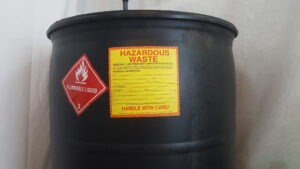Banks, as pillars of financial stability and responsibility, have a significant role to play in environmental stewardship. One area where this responsibility is particularly crucial is in the handling and disposal of hazardous waste drums. Hazardous waste poses risks to both human health and the environment if not managed properly. In this article, we’ll delve into the best practices for banks to deal with hazardous waste drums, ensuring they uphold their commitment to sustainability and safeguarding the communities they serve.
Understanding Hazardous Waste
Before delving into how banks should handle hazardous waste drums, it’s essential to understand what constitutes hazardous waste. Hazardous waste includes substances that are harmful or potentially harmful to human health or the environment. These can range from toxic chemicals and flammable liquids to materials that are corrosive or reactive. Improper handling or disposal of such waste can lead to contamination of soil, water, and air, posing serious health risks and environmental damage.
Legal Obligations
Banks, like other businesses, are subject to regulations regarding the handling and disposal of hazardous waste. Compliance with these regulations is not only a legal requirement but also a moral imperative. Failure to adhere to regulatory requirements can result in severe penalties, damage to reputation, and harm to the surrounding environment and communities. Therefore, banks must familiarize themselves with relevant laws and ensure strict adherence to them in their waste management practices.
Risk Assessment and Management
A crucial aspect of dealing with hazardous waste drums is conducting thorough risk assessments. Banks should identify and assess potential risks associated with the storage, transportation, and disposal of hazardous waste on their premises. This includes evaluating the types and quantities of hazardous waste generated, as well as assessing the adequacy of storage facilities and contingency plans for emergencies. By understanding and mitigating these risks, banks can minimize the likelihood of accidents or environmental incidents.
Proper Handling and Storage
Once hazardous waste drums are generated, proper handling and storage are paramount. Banks should establish clear protocols for handling and storing hazardous waste, including labeling, segregation, and containment measures. It’s essential to ensure that drums are securely sealed and stored in designated areas that are equipped to prevent leaks, spills, or unauthorized access. Additionally, staff should receive adequate training on proper handling procedures to minimize the risk of accidents and ensure compliance with regulations.
Transportation and Disposal
Transporting hazardous waste drums requires careful planning and adherence to safety regulations. Banks should work with licensed and reputable waste management companies to arrange for the safe transportation and disposal of hazardous waste. This involves selecting carriers with specialized equipment and trained personnel, as well as ensuring compliance with transportation regulations and permits. Proper documentation and tracking of waste shipments are also essential to ensure accountability and transparency throughout the disposal process.
Emergency Preparedness
Despite rigorous preventive measures, emergencies can still occur. Therefore, banks must have robust emergency preparedness and response plans in place to address potential incidents involving hazardous waste. This includes protocols for containing spills, notifying relevant authorities, and implementing remediation measures to minimize the impact on the environment and public health. Regular drills and training exercises can help ensure that staff are prepared to respond effectively to emergencies and mitigate risks.
Continuous Improvement
Effective waste management is an ongoing process that requires continuous evaluation and improvement. Banks should regularly review their waste management practices, identify areas for enhancement, and implement corrective actions as necessary. This may involve investing in new technologies or equipment to improve efficiency and safety, as well as updating policies and procedures in response to changes in regulations or best practices. By fostering a culture of continuous improvement, banks can strive towards achieving higher standards of environmental responsibility and sustainability.
Conclusion
In conclusion, banks have a responsibility to manage hazardous waste drums in a manner that protects human health, safeguards the environment, and complies with legal requirements. By understanding the risks associated with hazardous waste, implementing proper handling and storage protocols, and working with reputable waste management partners, banks can mitigate potential hazards and demonstrate their commitment to sustainability. Moreover, maintaining robust emergency preparedness and continuously striving for improvement are essential components of effective waste management practices. By adhering to these principles, banks can fulfill their role as responsible corporate citizens and contribute to a cleaner, safer future for all.


